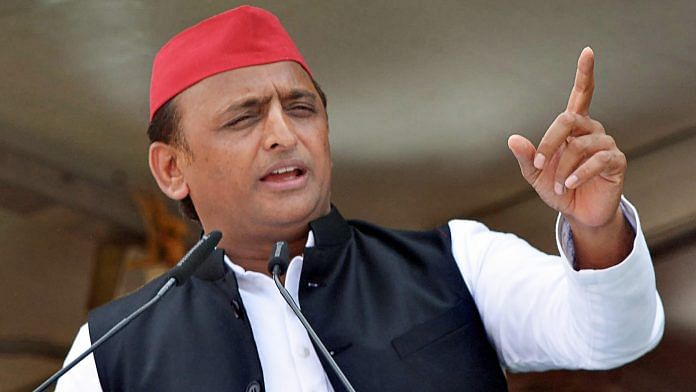The Samajwadi Party promises social justice, but what does its candidate list say? Caste and community based social equations dominate electoral strategies of political parties. However, such strategies cannot be understood without deciphering the caste and community profile of candidates.
The Samajwadi Party (SP) along with its principal allies – Suheldeo Bharatiya Samaj Party (SBSP) and Apna Dal (K) – have finalised candidates for 402 out of the 403 assembly constituencies in Uttar Pradesh for the 2022 election. The Akhilesh Yadav-led party has decided not to nominate a candidate against Aradhana Mishra ‘Mona’, the Congress Legislature Party leader from Rampur Khas constituency in Pratapgarh district, as a goodwill gesture since the Congress has not nominated candidates against Akhilesh Yadav and Shivpal Singh Yadav from Karhal and Jaswant Nagar constituencies. The Rampur Khas constituency is considered a stronghold of Congress leader Pramod Tiwari, and Aradhana Mishra is his daughter.
Based on my data on the profiles of candidates through telephonic conversation with local leaders, I provide a descriptive analysis of caste and community wise distribution of candidates of the Samajwadi Party and principal allies, Apna Dal (K) and SBSP. Apart from these two, many smaller parties are also part of the SP alliance, but their candidates are contesting on the election symbol of the SP since their symbols are not very well known in the constituencies.
Also read: What do UP voters want? This is what they told me about cow, Covid, Kashi
Who did the SP nominate?
Figure 1 shows the composition of candidates among broader categories – upper castes, backward castes, Scheduled Castes/Scheduled Tribes, and Muslim-plus minorities.
Figure 1
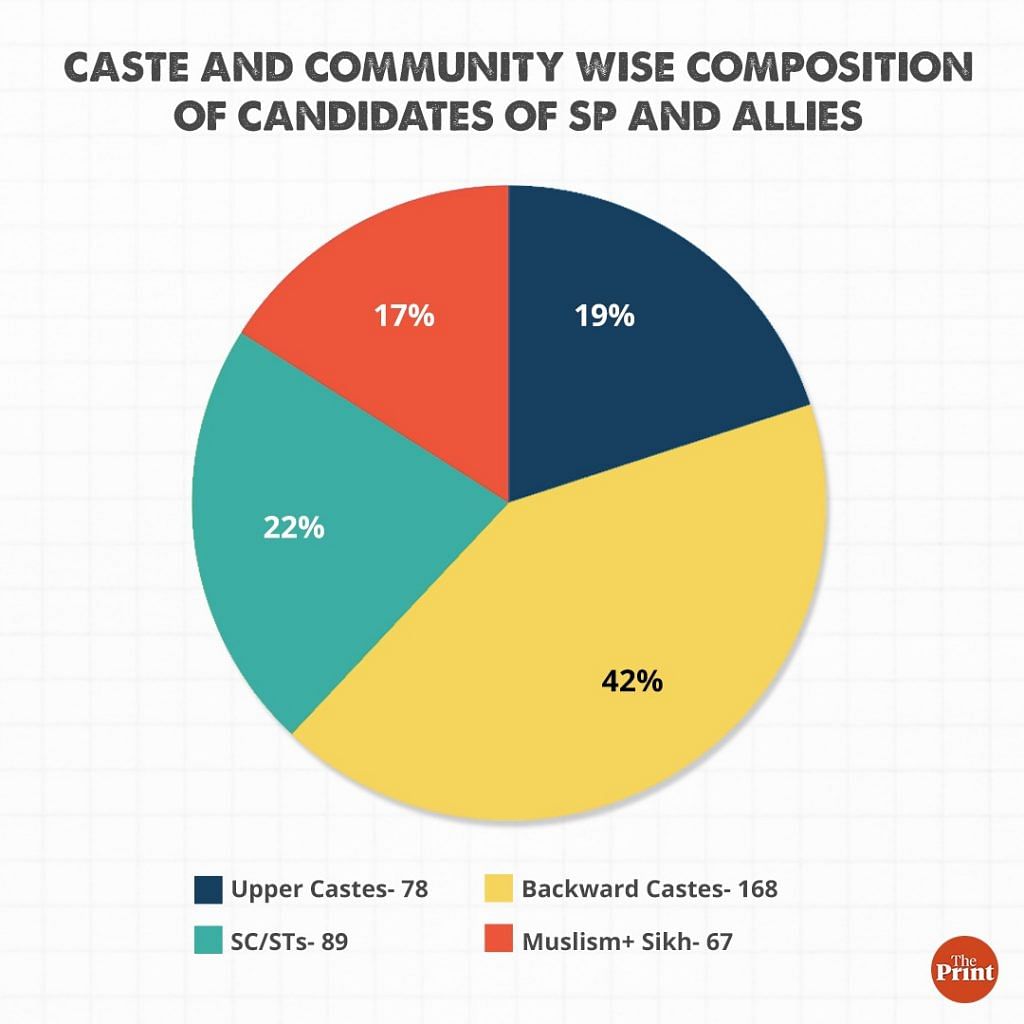
The above figure shows that the Hindu backward castes have been given 168 (42 per cent) seats, whereas upper castes have been given 78 (19 per cent) seats. Muslim backward castes have been included in Muslim candidates; so, the backward caste category only includes Hindu backward castes. The SCs/ST have been given 89 (22 per cent) seats and Muslims and Sikhs have been given 67 (17 per cent) seats. This distribution pattern reveals that the Samajwadi Party alliance has been cautious while nominating Muslim candidates for the assembly election. This could be due to Akhilesh Yadav’s efforts to do away with the label of the SP being a party of Yadavs and Muslims.
Relying on Brahmins
The composition of upper caste candidates shown in Figure 2 reveals that the alliance is heavily relying on Brahmin voters since it has nominated 40 (51 per cent) Brahmins. This could also be to attract Brahmin voters who have become ‘disillusioned’ with the Yogi Adityanath government.
The alliance has also nominated 22 (28 per cent) candidates from Rajput castes, despite the claim that Rajput voters are heavily polarised towards the Bharatiya Janata Party (BJP). Only 13 (17 per cent) candidates have been nominated from the Bania/Kayastha communities and 3 (4 per cent) from the Bhumihar castes. Voters from Bhumihar castes are found only in some eastern and western districts of Uttar Pradesh, but the same is not the case with Banias, who are said to be strong supporters of the BJP.
Figure 2
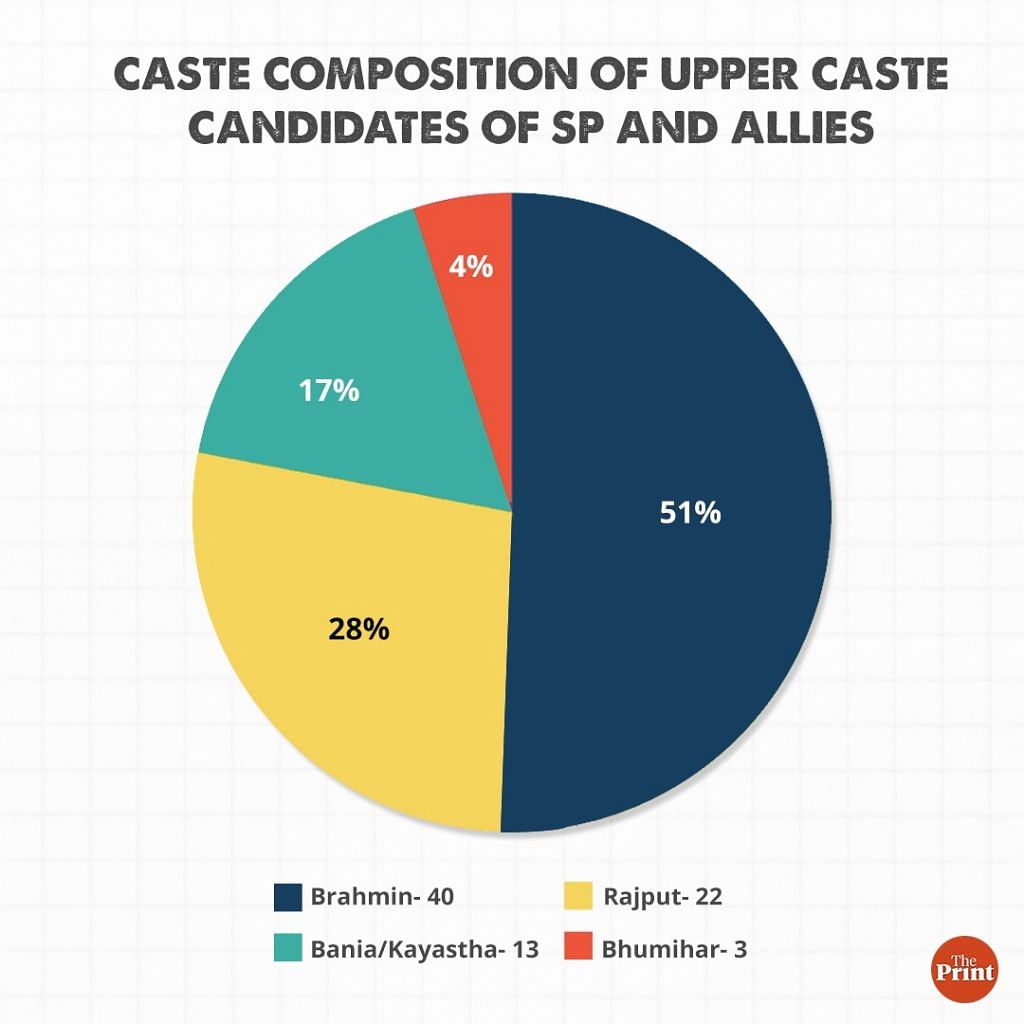
Also read: Rajbhar vs Rajbhar — how BJP is looking to defeat a former ally in UP seat it last won in 1996
Yadavs take lion’s share in OBCs
Figure 3 reveals that out of 168 candidates from Hindu backward castes or OBCs, Yadavs have got 53 (32 per cent) seats, followed by Kurmis/Sainthwars who have been given 34 (20 per cent) seats. SP ally Apana Dal (K) has nominated all candidates from the Kurmi caste in the constituencies that the party has got as seat share.
Figure 3
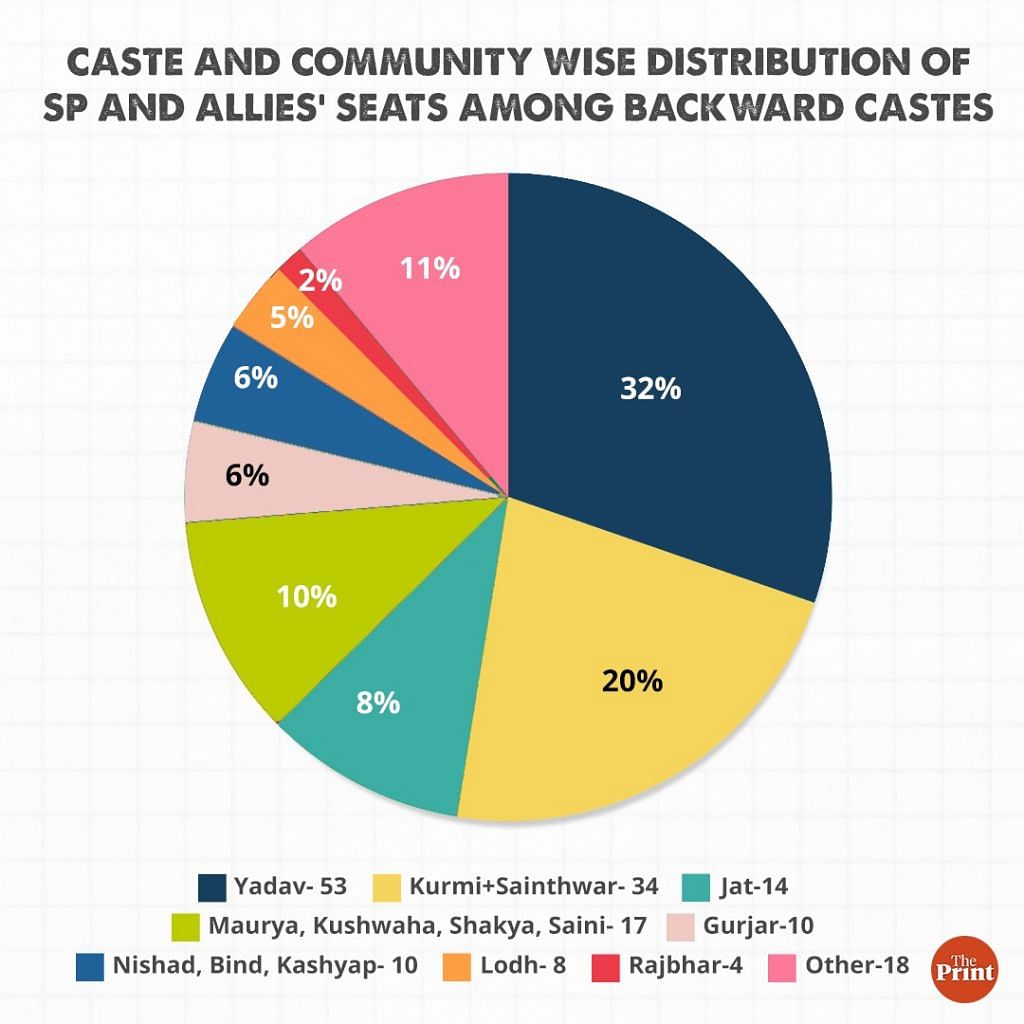
Jats have been given 14 (8 per cent) seats, and most Jat candidates are from the Rashtriya Lok Dal (RLD). The same is the case with Gurjars, who have been given 10 (6 per cent) seats. In western Uttar Pradesh, both SP and RLD have predominantly relied on Jat and Gurjar candidates in addition to Muslims. Two prominent leaders of the Maurya, Shakya, Kushwaha, and Saini communities—Swami Prasad Maurya and Dharam Singh Saini—joined the SP after the announcement of the election, and their communities have been given 17 (10 per cent) seats.
Nishads, Binds, and Kashyaps constitute the fisherman community of Uttar Pradesh and is present across most regions, but have been given only 10 (6 per cent) seats. Om Prakash Rajbhar has acquired fame in this election, but his Rajbhar caste has been given only 4 (2 per cent) seats, among which three candidates—Ram Achal Rajbhar and Kamalakant Rajbhar—are from the SP. The former has been a cabinet minister in the Mayawati government and national general secretary of the BSP, whereas the latter is the son of Sukhdeo Rajbhar, the veteran leader of the Rajbhar community. Om Prakash Rajbhar has not nominated any other person from his caste except his son. Only 18 (11 per cent) candidates have been nominated from the rest of the OBCs.
Also read: Law & order big hitch in SP’s push for non-Yadav OBCs in west UP. They’d rather vote back BJP
Attempt to break BSP’s core Jatav/Chamar voters
The SP has given special attention to winning reserved constituencies in this election. So, the alliance has not only been limited to nominating SC/ST candidates in reserved constituencies but also in unreserved constituencies. Total 86 constituencies are reserved for the SCs/STs in UP. The alliance has nominated four SC/ST candidates from general constituencies—Ghaziabad, Hardoi, Chauri Chaura, and Obra.
The caste composition of SC/ST candidates further reveals that the SP alliance has heavily relied on Chamars/Jatavs, who are core voters of the Bahujan Samaj Party (BSP). The alliance has nominated 38 (43 per cent) candidates from Chamar/Jatav castes in the hope that they will desert the BSP in this election. To do so, the SP inducted disgruntled Chamar/Jatav leaders from the BSP and nominated them as candidates. After them, Pasis have been given 29 (32 per cent) seats. Dhobis have been given 6 seats (7 per cent) and Khatiks 6 (7 per cent) seats each, and Koris has been given just 1 (<1 per cent) seats. All other SC/ST castes have been given 9 (10 per cent) seats.
Figure 4
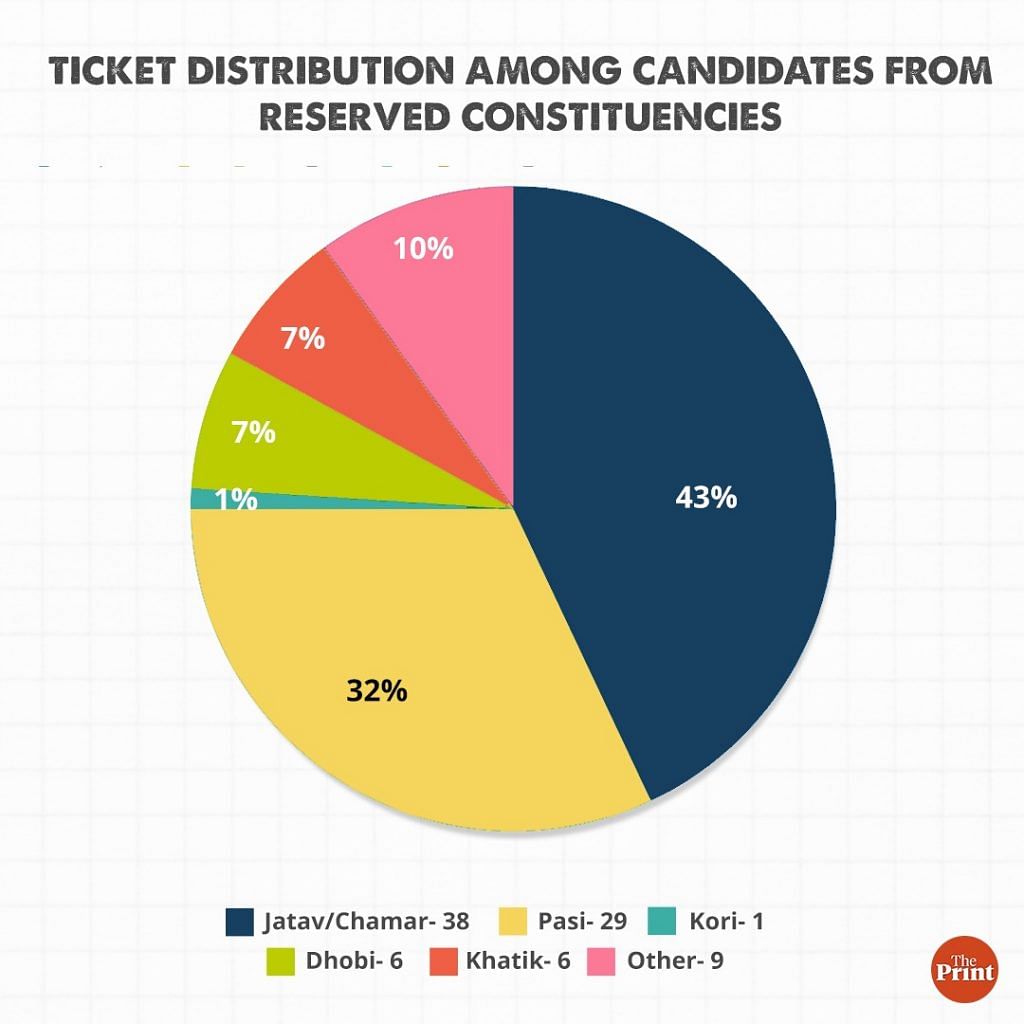
Although the SP and its alliance partners have tried to pitch the politics of social justice in this election, the candidate nomination strategy reveals they have largely relied on the politically mobilised sections among upper castes, backward castes, and SCs. Politically marginalised castes of each category remain inadequately represented in the candidate nomination.
Arvind Kumar (@arvind_kumar__), PhD in Politics, Department of Politics & IRs, Royal Holloway, University of London. Views are personal.
This article has been updated with new numbers.
Read all of Arvind Kumar’s articles on ticket distribution in UP elections here.


